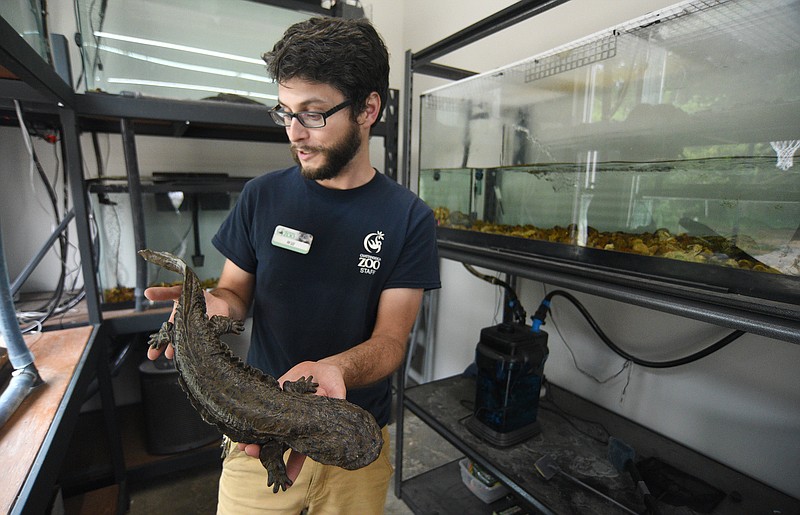Even though they can be hard to find in the wild, eastern hellbender salamanders always seem to attract a lot of attention, according to Thomas Floyd, a wildlife biologist with the Georgia Department of Natural Resources.
Floyd said his department issued a notice for Georgians to be on the lookout for hellbenders because people often see them this time of year. The request really "took off" on social media, Floyd said.
"Hellbenders are always a big hit, no matter what," he said.
There weren't any big surprises from the 50 or so hellbender sightings that have been reported since the department put out the call about a month ago, Floyd said. However, there were few sightings in Georgia from areas where there haven't been a documented occurrence before - one example being the Chattahoochee National Forest.
Floyd said there haven't been any sightings in Northwest Georgia for a while, but there were sightings in 2011 and 2014. "Every now and then, usually an angler, will come across a hellbender (in Northwest Georgia) and report it to us," he said.
The largest salamander in North America, hellbenders are usually found in cold, fast moving streams, Floyd said. They can grow up to 2 feet long and weigh up to 5 pounds.
Hellbenders, also known as snot otters and lasagna lizards, are hard to find in the wild because of their natural ability of camouflage, Floyd said. They're well adapted and hug the stream bottoms, and he said their heads look like rocks and tails look like dead leafs.
"It's like master Houdini, you see it one minute, the next minute it's gone. It's perfect camouflage to be such a big animal," Floyd said. "It's really cool."
Why are hellbenders so interesting to people? Floyd has a few ideas.
"It does have a cool set of nicknames, for sure. 'Snot otter' gets peoples attention," he said, and everyone he knows who sees one in the field is amazed. "For a slimy creature that's not like a cuddly, furry creature, it's pretty charismatic. It's a neat animal. It never gets old to see a hellbender."
Floyd said that if anyone spots a hellbender, also known as a devil dog, mud-devil, grampus, Allegheny alligator, mud dog, water dog, spotted water gecko, leverian water newt and mollyhugger, he can be contacted through email at thomas.floyd@dnr.ga.gov.
Include a photo if possible, he said, as well as the date, time and location of the sighting, and an estimation of the hellbender's size.
The Chattanooga Zoo opened the Hiwassee Hellbender Research and Education Facility in the spring of last year.
On a tour of the facility Friday, Andi Kurtz, Chattanooga Zoo marketing and social media coordinator, said the zoo has also recently partnered with the Tennessee Division of Forestry, Tennessee Wildlife Resources Agency and Lee University to raise hellbenders that will eventually go back into the wild.
"Originally, we were just looking at housing some that needed conservation for those that aren't able to be released, but then, with the Forestry Service, we have 91 babies that we just moved over here," Kurtz said. "So just today, all of our hellbenders are finally under the same roof."
(READ MORE: Chattanooga Zoo offers rare opportunity to experience the elusive hellbender up close)
In both Tennessee and Georgia, hellbender populations have declined because of how sensitive they are to water quality, said Kate Gore, animal care supervisor at the zoo. She said hellbenders essentially breathe through their skin, so the facility where the babies are kept is biosecure - meaning free of outside contaminants - and not open to the public.
"I've always wanted to do something to help animals beyond the zoo, so this is a dream come true," Gore said of the "headstart" program that began last fall. The zoo was given 108 eggs, and all of them hatched, she said.
On Sunday mornings at 11:30 a.m., zoo guests can come inside the facility and see the zoo's adult hellbenders in tanks and their re-created stream, Kurtz said. Any time the zoo is open, guests can see a hellbender tank through a window and learn more about them from an interpretive sign.
"That is the biggest issue they face, polluted water. And that's why we have such an elaborate setup, to make sure they all have constantly-moving water," Kurtz said. "The oxygenation is so important."
(READ MORE: Chattanooga continues local zoo with new 50-year lease)
Hellbenders can breathe air, Gore said, but moving water adds oxygen that they can process while staying underwater.
William Ternes, a herpetology keeper with the Chattanooga Zoo, said male hellbenders will use their tail to move water through eggs once they are deposited by females. To recreate the effect, its recommended that zookeepers shake the hellbender eggs on a daily basis.
Michael Freake, a professor of biology at Lee University, will replace the baby hellbenders in areas that are thriving, former hellbender habitat where the water quality has "bounced back" and some experimental habitat, Ternes said. Freake's unpublished radio tracking research found that hellbenders will travel miles to find a spot they like, Ternes said.
Despite all the hype and work done to ensure their survival, Ternes said hellbenders are most "relaxed and happy" when they're underneath a rock at the bottom of a river.
Contact Andrew Wilkins at awilkins@timesfreepress.com or 423-757-6659. Follow him on Twitter @tweetatwilkins.
